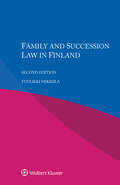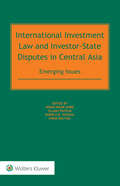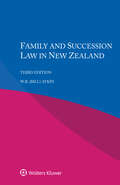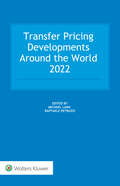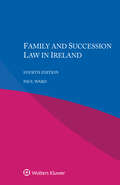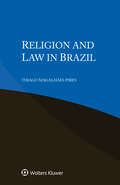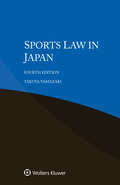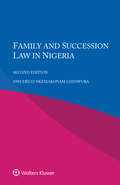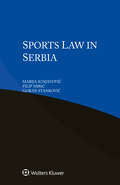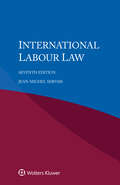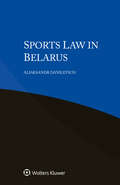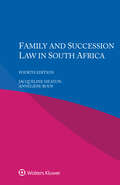- Table View
- List View
Family and Succession Law in Finland
by Tuulikki Mikkola<span style="font-size:10.0pt;mso-fareast-font-family:Times-Roman;mso-bidi-font-family: Times-Roman;color:black;mso-ansi-language:EN-GB">Derived from the renowned multi-volume <span style="font-size:10.0pt;mso-fareast-font-family:Times-Roman;mso-bidi-font-family: Times-Roman;color:black;mso-ansi-language:EN-GB">International Encyclopaedia of Law<span style="font-size:10.0pt;mso-fareast-font-family:Times-Roman;mso-bidi-font-family: Times-Roman;color:black;mso-ansi-language:EN-GB">s, <span style="font-size:10.0pt;mso-bidi-font-family:"Times New Roman"; color:black;mso-ansi-language:EN-GB">this concise exposition and analysis of the essential elements of law with regard to family relations, marital property, and <span style="font-size:10.0pt; mso-bidi-font-family:"Times New Roman";mso-ansi-language:EN-GB">succession to estates in Finland covers the legal rules and customs pertaining to the intertwined civic status of persons, the family, and property. <span style="font-size:10.0pt;mso-bidi-font-family:"Times New Roman";color:black; mso-ansi-language:EN-GB"> <span style="font-size:10.0pt;mso-bidi-font-family:"Times New Roman";color:black; mso-ansi-language:EN-GB">After an informative general introduction, the book proceeds to an in-depth discussion of the sources and instruments of family and succession law, the authorities that adjudicate and administer the laws, and issues surrounding the person as a legal entity and the legal disposition of property among family members. Such matters as nationality, domicile, and residence; marriage, divorce, and cohabitation; adoption and guardianship; succession and inter vivos arrangements; and the acquisition and administration of estates are all treated to a degree of depth that will prove useful in nearly any situation likely to arise in legal practice. <span style="font-size:10.0pt;mso-bidi-font-family:"Times New Roman";color:black; mso-ansi-language:EN-GB"> <span style="font-size:10.0pt;mso-bidi-font-family:"Times New Roman";color:black; mso-ansi-language:EN-GB">The book is primarily designed to assist lawyers who find themselves having to apply rules of international private law or otherwise handling cases connected with Finland. It will also be of great value to students and practitioners as a quick guide and easy-to-use practical resource in the field, and especially to academicians<span style="font-size: 10.0pt;mso-bidi-font-family:"Times New Roman";color:black"> and researchers engaged in comparative studies by providing the necessary, basic material of family and succession<span style="mso-fareast-font-family: Times-Roman;mso-bidi-font-family:Times-Roman;mso-ansi-language:EN-GB"> law.
International Investment Law and Investor-State Disputes in Central Asia: Emerging Issues
The five Central Asian States – Kazakhstan, the Kyrgyz Republic, Tajikistan, Turkmenistan and Uzbekistan – collectively present a unique case study for the nexus between international investment frameworks, investor-State dispute settlement (ISDS) and the future of this field. In this groundbreaking book, the editors have curated contributions from globally renowned practitioners and scholars to provide the first comprehensive overview of experiences and lessons arising from the region. This book draws upon the Central Asian experience with international investment law and ISDS to develop globally relevant insights and analyses on, among other topics: approaches to foreign direct investment and domestic investment legislation; jurisdictional questions arising in investment treaty arbitration, such as the notion of ‘investor’ and the definition of ‘investment’; the interpretation of investment treaties and the role of international and domestic law; substantive and procedural rights of foreign investors, with a focus on guarantees against expropriation and most-favoured nation and fair and equitable treatment standards; arbitral awards, as well as grounds and procedures for their enforcement and annulment; the state-of-play for allegations of corruption and fraud once a dispute has arisen; and emerging challenges and opportunities in light of ongoing reform initiatives. This book establishes that the Central Asian experience should be taken into consideration in any comprehensive and robust discussion on the future of international investment law and ISDS. It provides useful analyses of how these frameworks may be improved, reformed and remain fit for purpose. This book is an essential tool that allows practitioners, arbitrators, policymakers and scholars to confidently engage with the substantive and procedural challenges and opportunities that are anticipated in the next generation of investor-State disputes.
North Atlantic Treaty Organization (NATO)
by Anne Verhelst Snežana Trifunovska<span style="mso-fareast-font-family:Times-Roman;mso-bidi-font-family: Times-Roman;color:black;mso-ansi-language:EN-GB">Derived from the renowned multi-volume <span style="mso-fareast-font-family:Times-Roman;mso-bidi-font-family: Times-Roman;color:black;mso-ansi-language:EN-GB">International Encyclopaedia of Law<span style="mso-fareast-font-family:Times-Roman;mso-bidi-font-family: Times-Roman;color:black;mso-ansi-language:EN-GB">s, this practical analysis of the structure, competence, and management of <span style="font-size:10.5pt;font-family:"Arial",sans-serif;color:#333333; background:white">North Atlantic Treaty Organization (NATO)<span style="mso-fareast-font-family:Times-Roman;mso-bidi-font-family:Times-Roman; color:black;mso-ansi-language:EN-GB"> provides substantial and readily accessible information for lawyers, academics, and policymakers likely to have dealings with its activities and data. No other book gives such a clear, uncomplicated description of the organization’s role, its rules and how they are applied, its place in the framework of international law, or its relations with other organizations. <span style="mso-fareast-font-family:Times-Roman;mso-bidi-font-family: Times-Roman;color:black;mso-ansi-language:EN-GB">The monograph proceeds logically from the organization’s genesis and historical development to the structure of its membership, its various organs and their mandates, its role in intergovernmental cooperation, and its interaction with decisions taken at the national level. Its competence, its financial management, and the nature and applicability of its data and publications are fully described. <span style="font-size:12.0pt;font-family:"Times New Roman",serif; mso-fareast-font-family:Times-Roman;mso-bidi-font-family:Times-Roman; color:black;mso-font-kerning:.5pt;mso-ansi-language:EN-GB;mso-fareast-language: HI;mso-bidi-language:HI">Systematic in presentation, this valuable time-saving resource offers the quickest, easiest way to acquire a sound understanding of the workings of <span style="font-size:10.5pt;font-family:"Arial",sans-serif; mso-fareast-font-family:"Arial Unicode MS";color:#333333;background:white; mso-font-kerning:.5pt;mso-ansi-language:EN-US;mso-fareast-language:HI; mso-bidi-language:HI">North Atlantic Treaty Organization (NATO)for all interested parties. Students and teachers of international law will find it especially valuable as an essential component of the rapidly growing and changing global legal milieu.
Cyber Law in Bulgaria
by George Dimitrov Martin Zahariev<span style="mso-fareast-font-family:Times-Roman;mso-bidi-font-family: Times-Roman;color:black;mso-ansi-language:EN-GB">Derived from the renowned multi-volume <span style="mso-fareast-font-family:Times-Roman;mso-bidi-font-family: Times-Roman;color:black;mso-ansi-language:EN-GB">International Encyclopaedia of Law<span style="mso-fareast-font-family:Times-Roman;mso-bidi-font-family: Times-Roman;color:black;mso-ansi-language:EN-GB">s, this practical guide to cyber law – the law affecting information and communication technology (ICT) – in Bulgaria covers every aspect of the subject, including intellectual property rights in the ICT sector, relevant competition rules, drafting and negotiating ICT-related contracts, electronic transactions, privacy issues, and computer crime. Lawyers who handle transnational matters will appreciate the detailed explanation of specific characteristics of practice and procedure. Following a general introduction, the book assembles its information and guidance in seven main areas of practice: the regulatory framework of the electronic communications market; software protection, legal protection of databases or chips, and other intellectual property matters; contracts with regard to software licensing and network services, with special attention to case law in this area; rules with regard to electronic evidence, regulation of electronic signatures, electronic banking, and electronic commerce; specific laws and regulations with respect to the liability of network operators and service providers and related product liability; protection of individual persons in the context of the processing of personal data and confidentiality; and the application of substantive criminal law in the area of ICT. <span style="font-size:12.0pt;font-family:"Times New Roman",serif;mso-fareast-font-family: AdvP6F00;mso-bidi-font-family:AdvP6F00;mso-font-kerning:.5pt;mso-ansi-language: EN-US;mso-fareast-language:HI;mso-bidi-language:HI">Its succinct yet scholarly nature, as well as the practical quality of the information it provides, make this book a valuable time-saving tool for business and legal professionals alike. Lawyers representing parties with interests in Bulgaria will welcome this very useful guide, and academics and researchers will appreciate its value in the study of comparative law in this relatively new and challenging field.
Council of Europe (CoE)
by Tanja E.J. KleinsorgeDerived from the renowned multi-volume International Encyclopaedia of Laws, this practical analysis of the structure, competence, and management of Council of Europe provides substantial and readily accessible information for lawyers, academics, and policymakers likely to have dealings with its activities and data. No other book gives such a clear, uncomplicated description of the organization’s role, its rules and how they are applied, its place in the framework of international law, or its relations with other organizations. The monograph proceeds logically from the organization’s genesis and historical development to the structure of its membership, its various organs and their mandates, its role in intergovernmental cooperation, and its interaction with decisions taken at the national level. Its competence, its financial management, and the nature and applicability of its data and publications are fully described. Systematic in presentation, this valuable time-saving resource offers the quickest, easiest way to acquire a sound understanding of the workings of Council of Europe for all interested parties. Students and teachers of international law will find it especially valuable as an essential component of the rapidly growing and changing global legal milieu.
Intellectual Property Law: European Patent Convention
by Alexandru Cristian Strenc<span style="mso-fareast-font-family:Times-Roman;mso-bidi-font-family: Times-Roman;color:black;mso-ansi-language:EN-GB">Derived from the renowned multi-volume <span style="mso-fareast-font-family:Times-Roman;mso-bidi-font-family: Times-Roman;color:black;mso-ansi-language:EN-GB">International Encyclopaedia of Law<span style="mso-fareast-font-family:Times-Roman;mso-bidi-font-family: Times-Roman;color:black;mso-ansi-language:EN-GB">s, this monograph provides a survey and analysis of the rules concerning intellectual property rights in <span style="font-size:10.5pt;font-family:"Source Sans Pro",sans-serif; color:#333333;background:white">European Patent Convention<span style="mso-fareast-font-family:Times-Roman;mso-bidi-font-family: Times-Roman;color:black;mso-ansi-language:EN-GB">. It covers every type of intellectual property right in depth – copyright and neighbouring rights, patents, utility models, trademarks, trade names, industrial designs, plant variety protection, chip protection, trade secrets, and confidential information. Particular attention is paid throughout to recent developments and trends. <span style="mso-fareast-font-family:Times-Roman;mso-bidi-font-family: Times-Roman;color:black;mso-ansi-language:EN-GB">The analysis approaches each right in terms of its sources in law and in legislation, and proceeds to such legal issues as subject matter of protection, conditions of protection, ownership, transfer of rights, licences, scope of exclusive rights, limitations, exemptions, duration of protection, infringement, available remedies, and overlapping with other intellectual property rights. <span style="font-size:12.0pt;font-family:"Times New Roman",serif; mso-fareast-font-family:Times-Roman;mso-bidi-font-family:Times-Roman; color:black;mso-font-kerning:.5pt;mso-ansi-language:EN-GB;mso-fareast-language: HI;mso-bidi-language:HI">The book provides a clear overview of intellectual property legislation and policy, and at the same time offers practical guidance on which sound preliminary decisions may be based. Lawyers representing parties with interests in <span style="font-size:10.5pt;font-family:"Source Sans Pro",sans-serif; mso-fareast-font-family:"Arial Unicode MS";mso-bidi-font-family:Tahoma; color:#333333;background:white;mso-font-kerning:.5pt;mso-ansi-language:EN-US; mso-fareast-language:HI;mso-bidi-language:HI">European Patent Conventionwill welcome this very useful guide, and academics and researchers will appreciate its value in the study of comparative intellectual property law.
Labour Law in Belgium
by Frank Hendrickx<span style="mso-fareast-font-family:Times-Roman; mso-bidi-font-family:"Times New Roman";color:black;mso-ansi-language:EN-GB">Derived from the renowned multi-volume <span style="mso-fareast-font-family:Times-Roman; mso-bidi-font-family:"Times New Roman";color:black;mso-ansi-language:EN-GB">International Encyclopaedia of Laws<span style="mso-fareast-font-family:Times-Roman; mso-bidi-font-family:"Times New Roman";color:black;mso-ansi-language:EN-GB">, this monograph on Belgium not only describes and analyses the legal aspects of labour relations, but also examines labour relations practices and developing trends. It provides a survey of the subject that is both usefully brief and sufficiently detailed to answer most questions likely to arise in any pertinent legal setting. <span style="mso-fareast-font-family:Times-Roman;mso-bidi-font-family: "Times New Roman";color:black;mso-ansi-language:EN-GB">Both individual and collective labour relations are covered in ample detail, with attention to such underlying and pervasive factors as employment contracts, suspension of the contracts, dismissal laws and covenant of non-competition, as well as international private law. The author describes all important details of the law governing hours and wages, benefits, intellectual property implications, trade union activity, employers’ associations, workers’ participation, collective bargaining, industrial disputes, and much more. <span style="font-size:12.0pt;font-family:"Times New Roman",serif; mso-fareast-font-family:Times-Roman;color:black;mso-font-kerning:.5pt; mso-ansi-language:EN-GB;mso-fareast-language:HI;mso-bidi-language:HI">Building on a clear overview of labour law and labour relations, the book offers practical guidance on which sound preliminary decisions may be based. It will find a ready readership among lawyers representing parties with interests in Belgium, and academics and researchers will appreciate its value in the study of comparative trends in laws affecting labour and labour relations.
Family and Succession Law in New Zealand
by W. R. Bill Atkin<span style="font-size:10.0pt;mso-fareast-font-family:Times-Roman;mso-bidi-font-family: Times-Roman;color:black;mso-ansi-language:EN-GB">Derived from the renowned multi-volume <span style="font-size:10.0pt;mso-fareast-font-family:Times-Roman;mso-bidi-font-family: Times-Roman;color:black;mso-ansi-language:EN-GB">International Encyclopaedia of Law<span style="font-size:10.0pt;mso-fareast-font-family:Times-Roman;mso-bidi-font-family: Times-Roman;color:black;mso-ansi-language:EN-GB">s, <span style="font-size:10.0pt;mso-bidi-font-family:"Times New Roman"; color:black;mso-ansi-language:EN-GB">this concise exposition and analysis of the essential elements of law with regard to family relations, marital property, and <span style="font-size:10.0pt; mso-bidi-font-family:"Times New Roman";mso-ansi-language:EN-GB">succession to estates in New Zealand covers the legal rules and customs pertaining to the intertwined civic status of persons, the family, and property. <span style="font-size:10.0pt;mso-bidi-font-family:"Times New Roman";color:black; mso-ansi-language:EN-GB"> <span style="font-size:10.0pt;mso-bidi-font-family:"Times New Roman";color:black; mso-ansi-language:EN-GB">After an informative general introduction, the book proceeds to an in-depth discussion of the sources and instruments of family and succession law, the authorities that adjudicate and administer the laws, and issues surrounding the person as a legal entity and the legal disposition of property among family members. Such matters as nationality, domicile, and residence; marriage, divorce, and cohabitation; adoption and guardianship; succession and inter vivos arrangements; and the acquisition and administration of estates are all treated to a degree of depth that will prove useful in nearly any situation likely to arise in legal practice. <span style="font-size:10.0pt;mso-bidi-font-family:"Times New Roman";color:black; mso-ansi-language:EN-GB"> <span style="font-size:10.0pt;mso-bidi-font-family:"Times New Roman";color:black; mso-ansi-language:EN-GB">The book is primarily designed to assist lawyers who find themselves having to apply rules of international private law or otherwise handling cases connected with New Zealand. It will also be of great value to students and practitioners as a quick guide and easy-to-use practical resource in the field, and especially to academicians and researchers engaged in comparative studies by providing the necessary, basic material of family and succession<span style="mso-fareast-font-family:Times-Roman;mso-bidi-font-family:Times-Roman; mso-ansi-language:EN-GB"> law.
Medical Law in Ireland
by Deirdre Madden<span style="mso-fareast-font-family:Times-Roman;mso-bidi-font-family: Times-Roman;color:black;mso-ansi-language:EN-GB">Derived from the renowned multi-volume <span style="mso-fareast-font-family:Times-Roman;mso-bidi-font-family: Times-Roman;color:black;mso-ansi-language:EN-GB">International Encyclopaedia of Law<span style="mso-fareast-font-family:Times-Roman;mso-bidi-font-family: Times-Roman;color:black;mso-ansi-language:EN-GB">s, this convenient volume provides comprehensive analysis of the law affecting the physician-patient relationship in Ireland. Cutting across the traditional compartments with which lawyers are familiar, medical law is concerned with issues arising from this relationship, and not with the many wider juridical relations involved in the broader field of health care law. <span style="mso-fareast-font-family:Times-Roman;mso-bidi-font-family: Times-Roman;color:black;mso-ansi-language:EN-GB"> <span style="mso-fareast-font-family:Times-Roman;mso-bidi-font-family: Times-Roman;color:black;mso-ansi-language:EN-GB">After a general introduction, the book systematically describes law related to the medical profession, proceeding from training, licensing, and other aspects of access to the profession, through disciplinary and professional liability and medical ethics considerations and quality assurance, to such aspects of the physician-patient relationship as rights and duties of physicians and patients, consent, privacy, and access to medical records. Also covered are specific issues such as organ transplants, human medical research, abortion, and euthanasia, as well as matters dealing with the physician in relation to other health care providers, health care insurance, and the health care system. <span style="mso-fareast-font-family:Times-Roman;mso-bidi-font-family: Times-Roman;color:black;mso-ansi-language:EN-GB"> <span style="mso-fareast-font-family:Times-Roman;mso-bidi-font-family: Times-Roman;color:black;mso-ansi-language:EN-GB">Succinct and practical, this book will prove to be of great value to professional organizations of physicians, nurses, hospitals, and relevant government agencies. Lawyers representing parties with interests in Ireland will welcome this very useful guide, and academics and researchers will appreciate its comparative value as a contribution to the study of medical law in the international context.
Transfer Pricing Developments Around the World 2022
Intensive work on transfer pricing, one of the most relevant and challenging topics in the international tax environment, continues to increase worldwide at every level of government and international policy with a far-reaching impact on countries’ legislations, administrative guidelines, and jurisprudence. This book presents an in-depth, issue-by-issue analysis of the current state of developments along with suggestions for future solutions to the problems raised. Emerging from the research conducted by the WU Transfer Pricing Center at the Institute for Austrian and International Tax Law at WU (Vienna University of Economics and Business), this book offers eight topic-based chapters prepared by international experts on transfer pricing. Greatly helping to define recent transfer pricing issues around the world, this book encompasses the following topics: Global Transfer Pricing Developments. Transfer Pricing Developments in the European Union. Transfer Pricing Developments in the United States. Transfer Pricing Developments in Developing Countries and Emerging Economies. Recent Developments on Transfer Pricing in the Post-Covid-19 Era. Recent Developments on Transfer Pricing and Substance. Recent Developments on Transfer Pricing and Business Restructurings. Recent Developments on Transfer Pricing and New Technologies. The intense work of international organizations such as the OECD, UN, and other international organizations, as well as the intense work of the EU, is thoroughly analyzed in this book. The detailed analysis will be of immeasurable value to the various players, including international organizations, the business community and advisory firms, corporate CEOs and CFOs, and government officials as well as to tax lawyers, in-house counsel, and interested academics in facilitating efficient dialog and a coordinated approach to transfer pricing in the future.
Information Technology Law in Japan
by Masao YanagaDerived from the renowned multi-volume International Encyclopaedia of Laws, this practical guide to information technology law – the law affecting information and communication technology (ICT) – in Japan – covers every aspect of the subject, including the regulation of digital markets, intellectual property rights in the digital context, relevant competition rules, drafting and negotiating ICT-related contracts, electronic transactions, and cybercrime. Lawyers who handle transnational matters will appreciate the detailed explanation of specific characteristics of practice and procedure. Following a general introduction, the monograph assembles its information and guidance in six main areas of practice: (1) the regulatory framework of digital markets, including legal aspects of standardization, international private law applied to the online context, telecommunications law, regulation of audio-visual services and online commercial platforms; (2) online public services including e-government, e-health and online voting; (3) contract law with regard to software, hardware, networks and related services, with special attention to case law in this area, rules with regard to electronic evidence, regulation of electronic signatures, online financial services and electronic commerce; (4) software protection, legal protection of databases or chips, and other intellectual property matters; (5) the legal framework regarding cybersecurity and (6) the application of criminal procedure and substantive criminal law in the area of cybercrime. Its succinct yet scholarly nature, as well as the practical quality of the information it provides, make this monograph a valuable time-saving tool for business and legal professionals alike. Lawyers representing parties with interests in Japan will welcome this very useful guide, and academics and researchers will appreciate its value in the study of comparative law in this relatively new and challenging field.
Medical Law in Austria
by Aline Leischner-Lenzhofer Danielle Noe Claudia Steinböck Gisela Ernst<span style="mso-fareast-font-family:Times-Roman;mso-bidi-font-family: Times-Roman;color:black;mso-ansi-language:EN-GB">Derived from the renowned multi-volume <span style="mso-fareast-font-family:Times-Roman;mso-bidi-font-family: Times-Roman;color:black;mso-ansi-language:EN-GB">International Encyclopaedia of Law<span style="mso-fareast-font-family:Times-Roman;mso-bidi-font-family: Times-Roman;color:black;mso-ansi-language:EN-GB">s, this convenient volume provides comprehensive analysis of the law affecting the physician-patient relationship in Austria. Cutting across the traditional compartments with which lawyers are familiar, medical law is concerned with issues arising from this relationship, and not with the many wider juridical relations involved in the broader field of health care law. <span style="mso-fareast-font-family:Times-Roman;mso-bidi-font-family: Times-Roman;color:black;mso-ansi-language:EN-GB"> <span style="mso-fareast-font-family:Times-Roman;mso-bidi-font-family: Times-Roman;color:black;mso-ansi-language:EN-GB">After a general introduction, the book systematically describes law related to the medical profession, proceeding from training, licensing, and other aspects of access to the profession, through disciplinary and professional liability and medical ethics considerations and quality assurance, to such aspects of the physician-patient relationship as rights and duties of physicians and patients, consent, privacy, and access to medical records. Also covered are specific issues such as organ transplants, human medical research, abortion, and euthanasia, as well as matters dealing with the physician in relation to other health care providers, health care insurance, and the health care system. <span style="mso-fareast-font-family:Times-Roman;mso-bidi-font-family: Times-Roman;color:black;mso-ansi-language:EN-GB"> <span style="font-size:12.0pt;font-family:"Times New Roman",serif; mso-fareast-font-family:Times-Roman;mso-bidi-font-family:Times-Roman; color:black;mso-font-kerning:.5pt;mso-ansi-language:EN-GB;mso-fareast-language: HI;mso-bidi-language:HI">Succinct and practical, this book will prove to be of great value to professional organizations of physicians, nurses, hospitals, and relevant government agencies. Lawyers representing parties with interests in Austria will welcome this very useful guide, and academics and researchers will appreciate its comparative value as a contribution to the study of medical law in the international context.
Family and Succession Law in Ireland
by Paul Ward<span style="font-size:10.0pt;mso-fareast-font-family:Times-Roman;mso-bidi-font-family: Times-Roman;color:black;mso-ansi-language:EN-GB">Derived from the renowned multi-volume <span style="font-size:10.0pt;mso-fareast-font-family:Times-Roman;mso-bidi-font-family: Times-Roman;color:black;mso-ansi-language:EN-GB">International Encyclopaedia of Law<span style="font-size:10.0pt;mso-fareast-font-family:Times-Roman;mso-bidi-font-family: Times-Roman;color:black;mso-ansi-language:EN-GB">s, <span style="font-size:10.0pt;mso-bidi-font-family:"Times New Roman"; color:black;mso-ansi-language:EN-GB">this concise exposition and analysis of the essential elements of law with regard to family relations, marital property, and <span style="font-size:10.0pt;mso-bidi-font-family: "Times New Roman";mso-ansi-language:EN-GB">succession to estates in Ireland covers the legal rules and customs pertaining to the intertwined civic status of persons, the family, and property. <span style="font-size:10.0pt;mso-bidi-font-family:"Times New Roman";color:black; mso-ansi-language:EN-GB"> <span style="font-size:10.0pt;mso-bidi-font-family:"Times New Roman";color:black; mso-ansi-language:EN-GB">After an informative general introduction, the book proceeds to an in-depth discussion of the sources and instruments of family and succession law, the authorities that adjudicate and administer the laws, and issues surrounding the person as a legal entity and the legal disposition of property among family members. Such matters as nationality, domicile, and residence; marriage, divorce, and cohabitation; adoption and guardianship; succession and inter vivos arrangements; and the acquisition and administration of estates are all treated to a degree of depth that will prove useful in nearly any situation likely to arise in legal practice. <span style="font-size:10.0pt;mso-bidi-font-family:"Times New Roman";color:black; mso-ansi-language:EN-GB"> <span style="font-size:10.0pt;mso-bidi-font-family:"Times New Roman"; color:black;mso-font-kerning:.5pt;mso-ansi-language:EN-GB;mso-fareast-language: HI;mso-bidi-language:HI">The book is primarily designed to assist lawyers who find themselves having to apply rules of international private law or otherwise handling cases connected with Ireland. It will also be of great value to students and practitioners as a quick guide and easy-to-use practical resource in the field, and especially to academicians<span style="font-size:10.0pt;mso-bidi-font-family:"Times New Roman";color:black; mso-font-kerning:.5pt;mso-ansi-language:EN-US;mso-fareast-language:HI; mso-bidi-language:HI"> and researchers engaged in comparative studies by providing the necessary, basic material of family and succession<span style="font-size:12.0pt;font-family:"Times New Roman",serif; mso-fareast-font-family:Times-Roman;mso-bidi-font-family:Times-Roman; mso-font-kerning:.5pt;mso-ansi-language:EN-GB;mso-fareast-language:HI; mso-bidi-language:HI"> law.
Energy Law in Colombia
by Daniel Rincón Rubiano Luis Ferney Moreno Milton Montoya Pardo Adriana Martínez Villegas Ana Paola Gutiérrez Rico Daniela Aguilar Abaunza Juan Felipe Neira Lyndon Winston Jay Huffington Camila Cuberos Danna Caicedo Carlos Mantilla McCormick Luis Pando López Carlos Forero JiménezDerived from the renowned multi-volume International Encyclopaedia of Laws, this book provides a systematic approach to legislation and legal practice concerning energy resources and production in Colombia. The book describes the administrative organization, regulatory framework, and relevant case law pertaining to the development, application, and use of such forms of energy as electricity, gas, petroleum, and coal, with attention as needed to the pervasive legal effects of competition law, environmental law, and tax law. A general introduction covers the geography of energy resources, sources and basic principles of energy law, and the relevant governmental institutions. Then follows a detailed description of specific legislation and regulation affecting such factors as documentation, undertakings, facilities, storage, pricing, procurement and sales, transportation, transmission, distribution, and supply of each form of energy. Case law, intergovernmental cooperation agreements, and interactions with environmental, tax, and competition law are explained. Its succinct yet scholarly nature, as well as the practical quality of the information it provides, make this book a valuable resource for energy sector policymakers and energy firm counsel handling cases affecting Colombia. It will also be welcomed by researchers and academics for its contribution to the study of a complex field that today stands at the foreground of comparative law.
European Software Directives and European Software Patents
by Alexandru Cristian Strenc<span style="mso-fareast-font-family:Times-Roman;mso-bidi-font-family: Times-Roman;color:black;mso-ansi-language:EN-GB">Derived from the renowned multi-volume <span style="mso-fareast-font-family:Times-Roman;mso-bidi-font-family: Times-Roman;color:black;mso-ansi-language:EN-GB">International Encyclopaedia of Law<span style="mso-fareast-font-family:Times-Roman;mso-bidi-font-family: Times-Roman;color:black;mso-ansi-language:EN-GB">s, this monograph provides a survey and analysis of the rules concerning intellectual property rights in European Software Directives and European Software Patents<span style="mso-fareast-font-family:Times-Roman;mso-bidi-font-family: Times-Roman;color:black;mso-ansi-language:EN-GB">. It covers every type of intellectual property right in depth – copyright and neighbouring rights, patents, utility models, trademarks, trade names, industrial designs, plant variety protection, chip protection, trade secrets, and confidential information. Particular attention is paid throughout to recent developments and trends. <span style="mso-fareast-font-family:Times-Roman;mso-bidi-font-family: Times-Roman;color:black;mso-ansi-language:EN-GB">The analysis approaches each right in terms of its sources in law and in legislation, and proceeds to such legal issues as subject matter of protection, conditions of protection, ownership, transfer of rights, licences, scope of exclusive rights, limitations, exemptions, duration of protection, infringement, available remedies, and overlapping with other intellectual property rights. <span style="mso-fareast-font-family:Times-Roman;mso-bidi-font-family: Times-Roman;color:black;mso-ansi-language:EN-GB">The book provides a clear overview of intellectual property legislation and policy, and at the same time offers practical guidance on which sound preliminary decisions may be based. Lawyers representing parties with interests in European Software Directives and European Software Patents<span style="mso-fareast-font-family: Times-Roman;mso-bidi-font-family:Times-Roman;color:black;mso-ansi-language: EN-GB"> will welcome this very useful guide, and academics and researchers will appreciate its value in the study of comparative intellectual property law.
Religion and Law in Brazil
by Thiago Magalhães Pires<span style="mso-fareast-font-family:Times-Roman;mso-bidi-font-family: Times-Roman;color:black;mso-ansi-language:EN-GB">Derived from the renowned multi-volume <span style="mso-fareast-font-family:Times-Roman;mso-bidi-font-family: Times-Roman;color:black;mso-ansi-language:EN-GB">International Encyclopaedia of Laws<span style="mso-fareast-font-family:Times-Roman;mso-bidi-font-family: Times-Roman;color:black;mso-ansi-language:EN-GB">, this convenient resource provides systematic information on how Brazil deals with the role religion plays or can play in society, the legal status of religious communities and institutions, and the legal interaction among religion, culture, education, and media. <p style="text-align:justify;mso-pagination:widow-orphan; mso-hyphenate:auto;mso-layout-grid-align:none;text-autospace:none" class="MsoNormal"><span style="mso-fareast-font-family:Times-Roman;mso-bidi-font-family: Times-Roman;color:black;mso-ansi-language:EN-GB">After a general introduction describing the social and historical background, the book goes on to explain the legal framework in which religion is approached. Coverage proceeds from the principle of religious freedom through the rights and contractual obligations of religious communities; international, transnational, and regional law effects; and the legal parameters affecting the influence of religion in politics and public life. Also covered are legal positions on religion in such specific fields as church financing, labour and employment, and matrimonial and family law. A clear and comprehensive overview of relevant legislation and legal doctrine make the book an invaluable reference source and very useful guide. <p style="text-align:justify;mso-pagination:widow-orphan; mso-hyphenate:auto;mso-layout-grid-align:none;text-autospace:none" class="MsoNormal"><span style="font-size:12.0pt;font-family:"Times New Roman",serif; mso-fareast-font-family:Times-Roman;mso-bidi-font-family:Times-Roman; color:black;mso-font-kerning:.5pt;mso-ansi-language:EN-GB;mso-fareast-language: HI;mso-bidi-language:HI">Succinct and practical, this book will prove to be of great value to practitioners in the myriad instances where a law-related religious interest arises in Brazil. Academics and researchers will appreciate its value as a thorough but concise treatment of the legal aspects of diversity and multiculturalism in which religion plays such an important part.
Guide to Global Real Estate Investment Trusts
The global listed property sector has been characterized by a variety of noteworthy developments in recent times, the proliferation of real estate investment trust-type structures in countries around the world key among them. Despite an uncertain economic environment, REITs have proven their ability to promote institutional real estate investments in global financial markets. This highly practical book features a comprehensive analysis of both the legal and tax underpinnings of REIT-friendly legislation in a variety of the world’s most significant jurisdictions. With regard to the legal framework, the structure and functioning of a REIT are carefully investigated and explained. In terms of tax issues, the book focuses on such key issues as: REIT formation, operation and liquidation; mergers, acquisitions and dispositions; and planning for public and private REIT offerings and re-securitizations. REITs are inherently complex, and their interplay with tax treaties further compounds the complexity. This highly accessible yet authoritative work is the perfect decision-making tool for any professional looking for perspective and guidance on the challenges and opportunities REITs engender.
Information Technology Law in the United States of America
by McKay Cunningham Timothy MurphyDerived from the renowned multi-volume International Encyclopaedia of Laws, this practical guide to information technology law – the law affecting information and communication technology (ICT) – in the United States of America – covers every aspect of the subject, including the regulation of digital markets, intellectual property rights in the digital context, relevant competition rules, drafting and negotiating ICT<span style="mso-bookmark: CEGLog_Hyp_000008">-related contracts, electronic transactions, and cybercrime. Lawyers who handle transnational matters will appreciate the detailed explanation of specific characteristics of practice and procedure. Following a general introduction, the monograph assembles its information and guidance in six main areas of practice: (1) the regulatory framework of digital markets, including legal aspects of standardization, international private law applied to the online context, telecommunications law, regulation of audio-visual services and online commercial platforms; (2) online public services including e-government, e-health and online voting; (3) contract law with regard to software, hardware, networks and related services, with special attention to case law in this area, rules with regard to electronic evidence, regulation of electronic signatures, online financial services and electronic commerce; (4) software protection, legal protection of databases or chips, and other intellectual property matters; (5) the legal framework regarding cybersecurity and (6) the application of criminal procedure and substantive criminal law in the area of cybercrime. Its succinct yet scholarly nature, as well as the practical quality of the information it provides, make this monograph a valuable time-saving tool for business and legal professionals alike. Lawyers representing parties with interests in the United States of America will welcome this very useful guide, and academics and researchers will appreciate its value in the study of comparative law in this relatively new and challenging field.
Sports Law in Japan
by Takuya Yamazaki<span style="mso-fareast-font-family:"";mso-bidi-font-family:"Times New Roman"; mso-ansi-language:EN-GB">Derived from the renowned multi-volume <span style="mso-fareast-font-family:"";mso-bidi-font-family:"Times New Roman"; mso-ansi-language:EN-GB">International Encyclopaedia of Laws,<span style="mso-fareast-font-family:"";mso-bidi-font-family:"Times New Roman"; mso-ansi-language:EN-GB"> this practical analysis of sports law in Japan deals with the regulation of sports activity by both public authorities and private sports organizations. The growing internationalization of sports inevitably increases the weight of global regulation, yet each country maintains its own distinct regime of sports law and its own national and local sports organizations. Sports law at a national or organizational level thus gains a growing relevance in comparative law. <span style="mso-fareast-font-family:"";mso-bidi-font-family:"Times New Roman"; mso-ansi-language:EN-GB">The book describes and discusses both state-created rules and autonomous self-regulation regarding the variety of economic, social, commercial, cultural, and political aspects of sports activities. Self-regulation manifests itself in the form of by-laws, and encompasses organizational provisions, disciplinary rules, and rules of play. However, the trend towards more professionalism in sports and the growing economic, social and cultural relevance of sports have prompted an increasing reliance on legal rules adopted by public authorities. This form of regulation appears in a variety of legal areas, including criminal law, labour law, commercial law, tax law, competition law, and tort law, and may vary following a particular type or sector of sport. It is in this dual and overlapping context that such much-publicized aspects as doping, sponsoring and media, and responsibility for injuries are legally measured. <span style="font-size:12.0pt;font-family:"Times New Roman",serif; mso-fareast-font-family:"";mso-font-kerning:.5pt;mso-ansi-language:EN-GB; mso-fareast-language:HI;mso-bidi-language:HI">This monograph fills a gap in the legal literature by giving academics, practitioners, sports organizations, and policy makers access to sports law at this specific level. Lawyers representing parties with interests in Japan will welcome this very useful guide, and academics and researchers will appreciate its value in the study of comparative sports law.
Family and Succession Law in Nigeria
by Nwudego Nkemakonam ChinwubaDerived from the renowned multi-volume International Encyclopaedia of Laws, this concise exposition and analysis of the essential elements of law with regard to family relations, marital property, and succession to estates in Nigeria covers the legal rules and customs pertaining to the intertwined civic status of persons, the family, and property. After an informative general introduction, the book proceeds to an in-depth discussion of the sources and instruments of family and succession law, the authorities that adjudicate and administer the laws, and issues surrounding the person as a legal entity and the legal disposition of property among family members. Such matters as nationality, domicile, and residence; marriage, divorce, and cohabitation; adoption and guardianship; succession and inter vivos arrangements; and the acquisition and administration of estates are all treated to a degree of depth that will prove useful in nearly any situation likely to arise in legal practice. The book is primarily designed to assist lawyers who find themselves having to apply rules of international private law or otherwise handling cases connected with Nigeria. It will also be of great value to students and practitioners as a quick guide and easy-to-use practical resource in the field, and especially to academicians and researchers engaged in comparative studies by providing the necessary, basic material of family and succession law.
Sports Law in Serbia
by Marija Ignjatović Filip Mirić Goran Stanković<span style="mso-fareast-font-family:"";mso-bidi-font-family:"Times New Roman"; mso-ansi-language:EN-GB">Derived from the renowned multi-volume <span style="mso-fareast-font-family:"";mso-bidi-font-family:"Times New Roman"; mso-ansi-language:EN-GB">International Encyclopaedia of Laws<span style="mso-fareast-font-family:"";mso-bidi-font-family:"Times New Roman"; mso-ansi-language:EN-GB">, this practical analysis of sports law in Serbia deals with the regulation of sports activity by both public authorities and private sports organizations. The growing internationalization of sports inevitably increases the weight of global regulation, yet each country maintains its own distinct regime of sports law and its own national and local sports organizations. Sports law at a national or organizational level thus gains a growing relevance in comparative law. <span style="mso-fareast-font-family:"";mso-bidi-font-family:"Times New Roman"; mso-ansi-language:EN-GB">The book describes and discusses both state-created rules and autonomous self-regulation regarding the variety of economic, social, commercial, cultural, and political aspects of sports activities. Self- regulation manifests itself in the form of by-laws, and encompasses organizational provisions, disciplinary rules, and rules of play. However, the trend towards more professionalism in sports and the growing economic, social and cultural relevance of sports have prompted an increasing reliance on legal rules adopted by public authorities. This form of regulation appears in a variety of legal areas, including criminal law, labour law, commercial law, tax law, competition law, and tort law, and may vary following a particular type or sector of sport. It is in this dual and overlapping context that such much-publicized aspects as doping, sponsoring and media, and responsibility for injuries are legally measured. <span style="font-size:12.0pt;font-family:"Times New Roman",serif; mso-fareast-font-family:"";mso-font-kerning:.5pt;mso-ansi-language:EN-GB; mso-fareast-language:HI;mso-bidi-language:HI">This monograph fills a gap in the legal literature by giving academics, practitioners, sports organizations, and policy makers access to sports law at this specific level. Lawyers representing parties with interests in Serbia will welcome this very useful guide, and academics and researchers will appreciate its value in the study of comparative sports law.
Energy Law in Germany
by Henning Thomas<span style="font-size:12.0pt;font-family:"Times New Roman",serif; mso-ansi-language:EN-GB">Derived from the renowned multi-volume <span style="font-size:12.0pt;font-family:"Times New Roman",serif; mso-ansi-language:EN-GB">International Encyclopaedia of Law<span style="font-size:12.0pt;font-family:"Times New Roman",serif; mso-ansi-language:EN-GB">s, this book provides a systematic approach to legislation and legal practice concerning energy resources and production in Germany. The book describes the administrative organization, regulatory framework, and relevant case law pertaining to the development, application, and use of such forms of energy as electricity, gas, petroleum, and coal, with attention as needed to the pervasive legal effects of competition law, environmental law, and tax law. <span style="mso-bidi-font-family:"Times New Roman";mso-ansi-language: EN-GB">A general introduction covers the geography of energy resources, sources and basic principles of energy law, and the relevant governmental institutions. Then follows a detailed description of specific legislation and regulation affecting such factors as documentation, undertakings, facilities, storage, pricing, procurement and sales, transportation, transmission, distribution, and supply of each form of energy. Case law, intergovernmental cooperation agreements, and interactions with environmental, tax, and competition law are explained. <span style="mso-bidi-font-family:"Times New Roman";mso-ansi-language: EN-GB"> <span style="font-size:12.0pt;font-family:"Times New Roman",serif; mso-ansi-language:EN-GB">Its succinct yet scholarly nature, as well as the practical quality of the information it provides, make this book a valuable resource for energy sector policymakers and energy firm counsel handling cases affecting Germany. It will also be welcomed by researchers and academics for its contribution to the study of a complex field that today stands at the foreground of comparative law.
International Labour Law
by Jean-Michel ServaisNo one will deny that labour standards comprise a necessary framework for balanced economic and social development. Yet on a global level such balanced development has not occurred, despite the existence of a rigorous body of international labour law that has been active and growing for almost one hundred years. The implementation of this law devolves upon states; yet many states have failed to honour it. If we are to take serious steps toward a remedy for this situation, there is no better place to start than a thorough, well-researched survey and analysis of existing international labour law - its sources, its content, its historical development, and an informed consideration of the barriers to its full effectiveness. This book is exactly such a resource. It provides in-depth interpretation of the crucial International Labour Organisation (ILO) instruments - Constitution, conventions, declarations, resolutions, and recommendations - as well as such other sources of law as the OECD Guidelines for Multinational Enterprises and various model and actual corporate codes of conduct. Among the substantive areas of labour law covered in this book are the following: the relationship between international labour law and economic competition standards on industrial relations collective bargaining and dispute settlement procedures protection of trade unions prohibitions on enforced and child labour promotion of equal opportunity and treatment time and rest provisions wage determination and protection occupational health and safety provisions special issues on non-standard forms of employment foreign and migrant workers social security provisions privacy protection precarious work The presentation demonstrates that these rules and standards offer invaluable benchmarks to governments, judiciaries, employers, and trade unions. The book’s combination of detailed commentary and an overarching social policy will make it especially valuable to legislators, human resources managers, employers’ organizations, trade unions, jurists, and academics concerned with the role of work in our globalized social system. <span style="font-size:12.0pt;font-family:"Times New Roman",serif;mso-fareast-font-family: "Arial Unicode MS";mso-bidi-font-family:Tahoma;mso-font-kerning:.5pt; mso-ansi-language:EN-US;mso-fareast-language:HI;mso-bidi-language:HI">This seventh edition of the book by Jean-Michel Servais analyses the potential of those standards in a globalized world, and the necessary evolution. It examines the actual implementation of those rules in the national context, comparing different experiences. It integrates the latest instruments. It examines the most recent public debates on labour regulation (dealing with health and security at work, personal data, minimum wages, social security, strikes, etc.), updates the bibliography and opens some perspectives for the future work of the global institutions.
Sports Law in Belarus
by Aliaksandr Danilevich<span style="mso-fareast-font-family:"";mso-bidi-font-family:"Times New Roman"; mso-ansi-language:EN-GB">Derived from the renowned multi-volume <span style="mso-fareast-font-family:"";mso-bidi-font-family:"Times New Roman"; mso-ansi-language:EN-GB">International Encyclopaedia of Laws<span style="mso-fareast-font-family:"";mso-bidi-font-family:"Times New Roman"; mso-ansi-language:EN-GB">, this practical analysis of sports law in Belarus deals with the regulation of sports activity by both public authorities and private sports organizations. The growing internationalization of sports inevitably increases the weight of global regulation, yet each country maintains its own distinct regime of sports law and its own national and local sports organizations. Sports law at a national or organizational level thus gains a growing relevance in comparative law. <span style="mso-fareast-font-family:"";mso-bidi-font-family:"Times New Roman"; mso-ansi-language:EN-GB">The book describes and discusses both state-created rules and autonomous self-regulation regarding the variety of economic, social, commercial, cultural, and political aspects of sports activities. Self- regulation manifests itself in the form of by-laws, and encompasses organizational provisions, disciplinary rules, and rules of play. However, the trend towards more professionalism in sports and the growing economic, social and cultural relevance of sports have prompted an increasing reliance on legal rules adopted by public authorities. This form of regulation appears in a variety of legal areas, including criminal law, labour law, commercial law, tax law, competition law, and tort law, and may vary following a particular type or sector of sport. It is in this dual and overlapping context that such much-publicized aspects as doping, sponsoring and media, and responsibility for injuries are legally measured. <span style="font-size:12.0pt;font-family:"Times New Roman",serif; mso-fareast-font-family:"";mso-font-kerning:.5pt;mso-ansi-language:EN-GB; mso-fareast-language:HI;mso-bidi-language:HI">This monograph fills a gap in the legal literature by giving academics, practitioners, sports organizations, and policy makers access to sports law at this specific level. Lawyers representing parties with interests in Belarus will welcome this very useful guide, and academics and researchers will appreciate its value in the study of comparative sports law.
Family and Succession Law in South Africa
by Jacqueline Heaton Anneliese RoosDerived from the renowned multi-volume International Encyclopaedia of Laws, this concise exposition and analysis of the essential elements of law with regard to family relations, marital property, and succession to estates in South Africa covers the legal rules and customs pertaining to the intertwined civic status of persons, the family, and property. After an informative general introduction, the book proceeds to an in-depth discussion of the sources and instruments of family and succession law, the authorities that adjudicate and administer the laws, and issues surrounding the person as a legal entity and the legal disposition of property among family members. Such matters as nationality, domicile, and residence; marriage, divorce, and cohabitation; adoption and guardianship; succession and inter vivos arrangements; and the acquisition and administration of estates are all treated to a degree of depth that will prove useful in nearly any situation likely to arise in legal practice. The book is primarily designed to assist lawyers who find themselves having to apply rules of international private law or otherwise handling cases connected with South Africa. It will also be of great value to students and practitioners as a quick guide and easy-to-use practical resource in the field, and especially to academicians and researchers engaged in comparative studies by providing the necessary, basic material of family and succession law.
